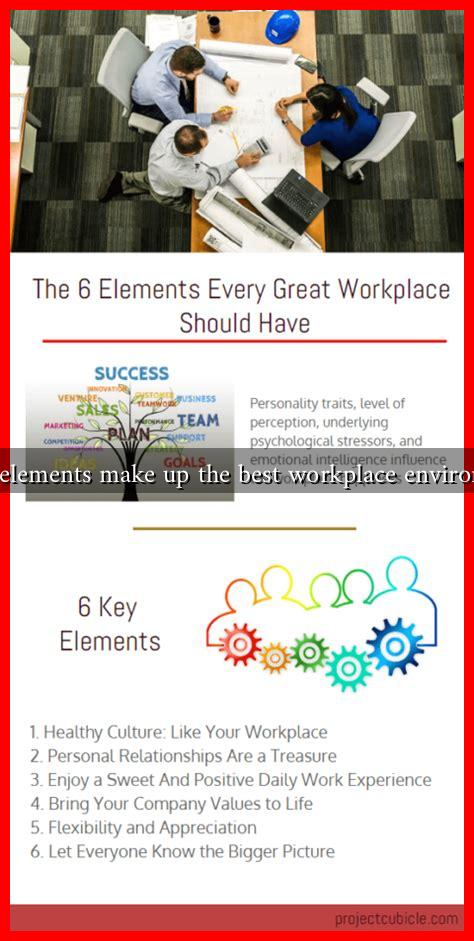-
Table of Contents
What Elements Make Up the Best Workplace Environment?
Creating an optimal workplace environment is essential for fostering employee satisfaction, productivity, and overall organizational success. A well-designed workplace not only enhances employee morale but also contributes to lower turnover rates and higher levels of engagement. In this article, we will explore the key elements that constitute the best workplace environment, supported by research, examples, and statistics.
1. Physical Workspace Design
The physical layout of a workplace significantly impacts employee performance and well-being. A well-thought-out design can promote collaboration, creativity, and comfort. Key aspects include:
- Open Spaces: Open-plan offices encourage communication and teamwork. Companies like Google and Facebook have adopted this model to foster collaboration among employees.
- Quiet Zones: While open spaces are beneficial, quiet areas are essential for focused work. Companies like Microsoft have incorporated soundproof rooms for employees needing solitude.
- Ergonomic Furniture: Providing adjustable desks and ergonomic chairs can reduce physical strain and enhance comfort, leading to increased productivity.
According to a study by the American Society of Interior Designers, 90% of employees believe that the design of their workspace affects their productivity.
2. Company Culture and Values
A positive company culture is a cornerstone of a great workplace environment. It encompasses the values, beliefs, and behaviors that shape how employees interact with one another and with the organization. Key elements include:
- Inclusivity: A culture that promotes diversity and inclusion leads to a more innovative workforce. Companies like Salesforce have made significant strides in creating an inclusive environment.
- Recognition and Appreciation: Regularly acknowledging employee contributions fosters a sense of belonging and motivation. A Gallup study found that employees who receive regular recognition are more productive and engaged.
- Work-Life Balance: Encouraging employees to maintain a healthy work-life balance can reduce burnout and increase job satisfaction. Flexible working hours and remote work options are examples of how companies can support this balance.
3. Opportunities for Growth and Development
Employees are more likely to stay with a company that invests in their professional development. Providing opportunities for growth can take various forms:
- Training Programs: Offering workshops and training sessions helps employees enhance their skills. Companies like Amazon have invested heavily in employee training, resulting in higher retention rates.
- Mentorship Opportunities: Pairing less experienced employees with seasoned mentors can facilitate knowledge transfer and career advancement.
- Clear Career Pathways: Providing a transparent framework for career progression can motivate employees to strive for advancement within the organization.
According to LinkedIn’s 2021 Workplace Learning Report, 94% of employees would stay at a company longer if it invested in their career development.
4. Effective Communication
Open and transparent communication is vital for a healthy workplace environment. It fosters trust and collaboration among team members. Key strategies include:
- Regular Check-Ins: Frequent one-on-one meetings between managers and employees can help address concerns and provide feedback.
- Feedback Mechanisms: Implementing anonymous surveys or suggestion boxes allows employees to voice their opinions without fear of repercussions.
- Team Collaboration Tools: Utilizing platforms like Slack or Microsoft Teams can enhance communication and streamline workflows.
A study by the Institute for Corporate Productivity found that organizations with effective communication practices are 50% more likely to have lower employee turnover.
5. Health and Well-Being Initiatives
Promoting employee health and well-being is crucial for maintaining a productive workplace. Companies can implement various initiatives:
- Wellness Programs: Offering fitness classes, mental health resources, and health screenings can improve overall employee well-being.
- Healthy Work Environment: Ensuring access to natural light, plants, and clean air can enhance employee mood and productivity.
- Stress Management Resources: Providing access to counseling services or stress management workshops can help employees cope with workplace pressures.
According to the Global Wellness Institute, companies that invest in employee wellness see a return of $3.27 for every dollar spent.
Conclusion
In summary, the best workplace environment is characterized by a thoughtful physical workspace design, a positive company culture, opportunities for growth, effective communication, and a focus on health and well-being. By prioritizing these elements, organizations can create a thriving workplace that not only attracts top talent but also retains and engages employees. As the workplace continues to evolve, companies that adapt to these needs will undoubtedly lead the way in fostering a productive and satisfying work environment.
For further insights on workplace environments, consider exploring resources from the Gallup Organization and the Global Wellness Institute.


